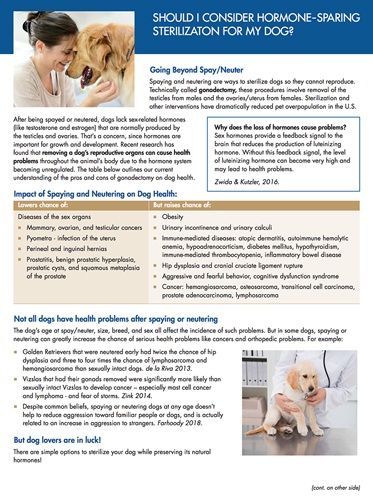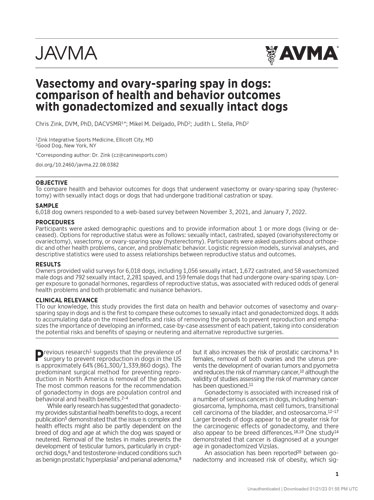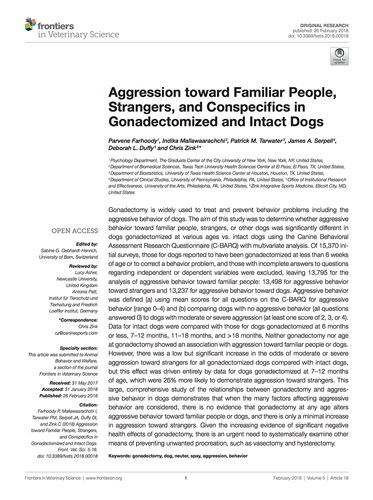Alternative Surgical Sterilization
In response to recent published scientific studies and other personal concerns, some dog owners seek a way to ensure that their dog does not reproduce yet still benefit from sex hormones throughout life. At Pets In Stitches, alternative sterilization options – ovary sparing spay (hysterectomy) and vasectomy – are offered.
Latest Articles
Below are a few of the latest articles and publications we’ve found to be helpful in your journey to consider alternative sterilization.
SPAY
OVARY SPARING SPAY
Removes the ovaries and uterus, generally at the cervix.
Removes the uterus and cervix, while leaving one or both of the ovaries intact for physiologic, health, and/or behavioral reasons.
Surgeon must remove the entire uterus (no “stump”); otherwise, ovarian hormone exposure can cause uterine bacterial overgrowth and pyometra (infection of the remaining uterus tissue). Thus, the surgical incision will be larger than with an ovariohysterectomy.
No heat cycles, no ovarian hormones, no pregnancy possible.
Ovary is still functional, so heat cycle behavior and small amount of bleeding from vaginal membranes can still occur. Still attracted to males, will stand to mate. Still at risk of sexually transmitted diseases, other infection, or trauma from males. Cannot become pregnant since uterus is missing.
Mammary tumors are the only significant health risk remaining after a hysterectomy. Fifty percent of mammary tumors are malignant in dogs. Owners must stay alert to this possibility of mammary tumors as their dog ages.
Should still be confined away from males for the full three weeks of the heat cycle, to reduce the risk of injury from the attempted act of breeding and sexually transmitted diseases. Heat cycles generally will occur every six to nine months.
NEUTER
VASECTOMY
Removal of testicles. Not able to father a litter of puppies. Typically won’t mate, but some neutered males still engage in mating behaviors.
Removing a piece of the spermatic cord (vas deferens) to prevent transport of sperm from testicles during ejaculation.
Still displays typical male behaviors and characteristics, including desire to mate
Sexually transmitted diseases can also occur.
Eliminates risk of testicular cancers and benign prostatic hypertrophy (enlarged prostate). Reduces risk of prostatitis (infection of prostate).
Does not reduce risk for prostatitis, which can be life-threatening.
Does not always eliminate male marking behavior and should not be expected to stop roaming behavior.
Good fencing and/or leashing and supervision still necessary when outside to control wanderlust. Wandering and attempts to mate can lead to auto injuries or death.
Additional Information
Why Should You Consider?
No single sterilization recommendation can fit every dog and owner. The decision to traditionally sterilize, alternatively sterilize, age to perform such procedures, or leave intact rests on a foundation of science, dogma, and culture.
When breeders require sterilization in their puppy contract, yet dog owners still want the benefit of sex hormones.
When performance and show dogs will not be used for breeding.
For dog breeds that are prone to diseases and conditions that may occur more often when sex hormones are removed. Studies have been performed on breeds such as Golden Retrievers, Labrador Retrievers, Rottweilers, German Shepherd Dogs, and Vizslas examining various disease and behavior developments. Results indicate that the health and behavioral benefits of keeping sex hormones may outweigh the health risks of removing them. There is enough genetic breed variation that the studies’ results should not by applied to all other breeds. One should not assume that the presence of sex hormones will outweigh the benefits of traditional ovariohysterectomy or neuter for all breeds.
Read more about the impacts and what to consider for spaying and neutering your dog.
Before Surgery
We recommend completing or collecting required paperwork to bring with you so we may process your dog’s admission quickly the morning of surgery. These include:
Copy of any recent vaccination records
Copy of most recent rabies vaccine
Publications to Learn More
Do routine, elective gonadectomies really increase dogs’ lifespan? By Martin L. Whitehead, BSc, PhD, BVSc, CertSAM, MRCVS. April 11, 2023
Your Dog Needs To Be Spayed Or Neutered – Right? Will Falconer DVM. Dogs Naturally. November 16, 2021
An Ancient Practice but a New Paradigm: Personal Choice for the Age to Spay or Neuter a Dog. Lynette A. Hart* and Benjamin L. Hart. March 19, 2021
Webinar – Effects on Desexing on the Health of Dogs and Cats, Dr. Jeff Buckland BVSc (hons), Surgical Resident. August 19, 2020
Assisting Decision-Making on Age of Neutering for 35 Breeds of Dogs: Associated Joint Disorders, Cancers, and Urinary Incontinence. Benjamin L. Hart, Lynette A. Hart, Abigail P. Thigpen, and Neil H. Willits. July 7, 2020
Alternatives to traditional spay and neuter – evolving best practices in dog sterilization. Linda Brent, PhD, MBA and Michelle Kutzler, DVM, PhD, DACT. Innovative Veterinary Care. October 26, 2018
Understanding Data on Hormones, Behavior and Neoplasia. University of Georgia College of Veterinary Medicine. June 2018
A literature review on the welfare implications of gonadectomy of dogs. Kendall E. Houlihan, DVM. May 15, 2017
Age of Neutering in large & giant breed dogs. Clara S.S. Goh, BVSc, MS, DACVS (Small Animal), ACVS Founding Fellow (Surgical Oncology). August 2016
Non-Reproductive Long-Term Health Complications of Gonad Removal in Dogs as Well as Possible Causal Relationships with Post-Gonadectomy Elevated Luteinizing Hormone (LH) Concentrations. KhawlaZwida and Michelle Anne Kutzler. Journal of Etiology and Animal Health. March 8, 2016.
Neutering of German Shepherd Dogs: associated joint disorders, cancers and urinary incontinence. Benjamin L. Hart, Lynette A. Hart, Abigail P. Thigpen and Neil H. Willits. 2016
Long-Term Health Effects of Neutering Dogs: Comparison of Labrador Retrievers with Golden Retrievers. Benjamin L. Hart, Lynette A. Hart, Abigail P. Thigpen, Neil H. Willits. July 2014
Beyond Gonadectomy – Sterilization to Retain Normal Hormones. Sara Fox Chapman, MS, DVM, MRCVS, VetMFHom. The Alpenhorn. June 2014.
Evaluation of the risk and age of onset of cancer and behavioral disorders in gonadectomized Vizslas. M. Christine Zink, DVM, PhD; Parvene Farhoody, MA; Samra E. Elser, BS; Lynda D. Ruffini; Tom A. Gibbons, MS; Randall H. Rieger, PhD. February 1, 2014
The gonad chronicles, part 2: Veterinary research explores neutering’s elusive impact. Karen L. Overall, MA, VMD, PhD, DACVB, CAAB. DVM360 Magazine. Jan 1, 2014.
The gonad chronicles part 1: Neutering’s newest controversy. Karen L. Overall, MA, VMD, PhD, DACVB, CAAB. DVM360 Magazine. Dec 1, 2013.
Effect of age at gonadectomy on the probability of dogs becoming overweight. Sandra L. Lefebvre, DVM, PhD; Mingyin Yang, BVMS, MS; Mansen Wang, PhD; Denise A. Elliott, BVSc, PhD, DACVIM, DACVN; Preston R. Buff, PhD; Elizabeth M. Lund, DVM, MPH, PhD. July 15, 2013
Spayed but Still Sexy: Notes on heat cycles in my OSS bitch. Emily Hilgenberg. May 23, 2013.
Evaluation of the prevalence of urinary incontinence in spayed female dogs: 566 cases (2003–2008). Kara M. Forsee, DVM; Garrett J. Davis, DVM, DACVS; Emily E. Mouat, DVM; Katharine R. Salmeri, DVM, DACVS; Richard P. Bastian, PhD. April 1, 2013
Neutering Dogs: Effects on Joint Disorders and Cancers in Golden Retrievers. Gretel Torres de la Riva, Benjamin L. Hart, Thomas B. Farver, Anita M. Oberbauer, Locksley L. McV Messam, Neil Willits, Lynette A. Hart. February 2013
Can Spaying Lead to Bad Behavior? Sophia Yin, DVM. March 5, 2009.
Determining The Best Age At Which To Spay Or Neuter. Margaret Root-Kustritz, DVM, PhD, University of Minnesota. April 24, 2008. akcchf.org.
Countering the Pushback Against Spay/Neuter. Natalie Isaza, DVM. See page 6 onwards.
Spaying and Neutering. American Veterinary Medical Association.
Should I Consider Hormone-Sparing Sterilization For My Dog? Parsemus Foundation
Ovary Sparing Spay and Vasectomy Info Group. (Facebook Group)
Alternative Sterilization FAQs
Interested in more frequently asked questions? View more



